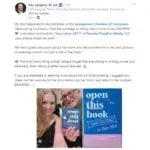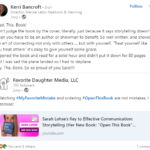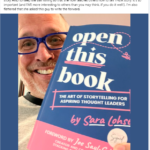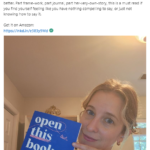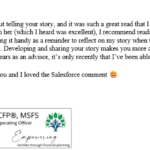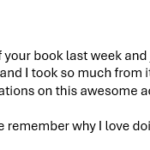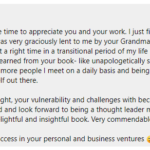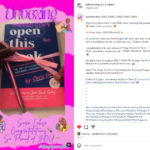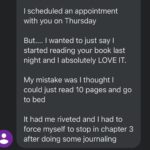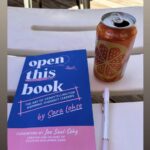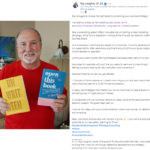#1 BEST SELLING NEW RELEASE
Open This Book
The Art of Storytelling for Aspiring Thought Leaders
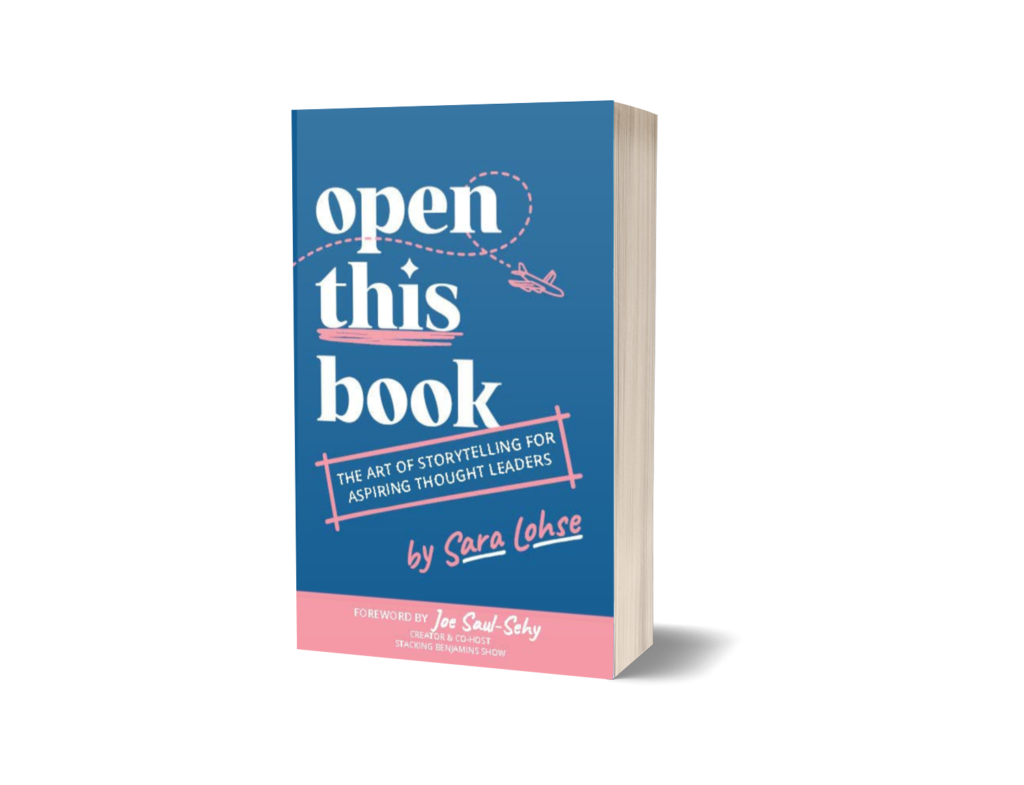
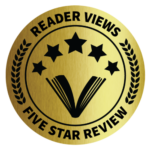
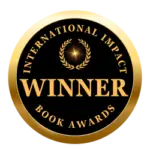
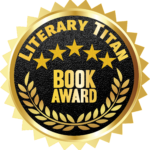
"Not my kind of book, but good for you."
Sara's Grandmother
Everyone has a story, they just don't know it yet.
Open This Book is your backstage pass to understanding why storytelling isn’t just for the Shakespeares and Spielbergs of the world. Designed as part book, part journal (but no part textbook), this isn’t your typical “how-to” guide. It’s a candid, relatable conversation that shows you how to transform life’s chaos into clarity and make your voice the one your audience remembers.
Whether you’re a content creator, podcaster, speaker, or aspiring leader, you’ll discover how to turn everyday moments—mishaps, successes, and all—into stories that captivate and connect.
So, if you’re ready to turn your misadventures into your mission statement, you’ve come to the right place. Because if there’s one thing I’ve learned, it’s that the best stories are hiding in plain sight—they just need a little nudge (or a full-on shove) into the spotlight.
This isn’t just about finding your voice; it’s about discovering that your voice, quirks and all, is exactly what the world’s been waiting to hear.
What are you waiting for? Open this book.
Amazon Reviews
Editorial Reviews
Got a story to share but don’t know how to tell it? Or maybe you like telling stories but don’t know how to put them to use in your career or personal life. Either way, “Open This Book: The Art of Storytelling for Aspiring Thought Leaders” by Sara Lohse is the book for you. Maybe you tell stories to pass the time at work. Guess what? You’re connecting with people. How? Let the author explain it all in her friendly and conversational way. She’s done the research, checked out the statistics and run the data. Now she’s here to share with you everything you need to know about storytelling – and how you can put it to use for you.
The author writes in the introduction:
This book is a call to action for anyone who has ever sensed a story bubbling within them but didn’t quite know how to harness its power.
I have seen the power of storytelling in a former job. It was one that was stressful and difficult at times. But the moments when I would tell stories about something funny that happened or something interesting that took place, helped those listening to the stories to laugh and feel a sense of wonder. Stories have power. They can lift a person’s spirits or inspire them to act. To this day, I still tell stories—if I can find people who will listen.
And while I may be used to telling stories, not everyone is. In fact, some people may have anxiety about sharing a personal story. “Open This Book” is made for a situation like this. Not only will it help those folks figure out how to tell their stories or what stories to share, it will also help them get past that anxiety. Imposter syndrome is one thing that holds people back, but it’s not the only thing; it’s also ageism and insecurities. This book addresses those issues, as well. So, if you’re in that boat, turn to this book for guidance and suggestions on how to move forward.
I really enjoyed reading the chapter on imposter syndrome, which seems to be happening to a lot of people these days (if what I have seen on social media feeds are anything to go by). Even though the author was sharing her own experiences with imposter syndrome, there is a lot of takeaway value from her stories. And the best thing is something she tells a person on page 54:
Everyone has something to teach.
This book may be about how telling stories can help you move forward in your career, nurture connections with others and help guide you in making decisions, but it also talks about storytelling itself. It provides information about the neuroscience of storytelling and the different kinds of stories for different types of situations, as well as how they serve different purposes.
What is it about storytelling that we love so much? Is it the drive to connect with others? Or is it a great form of entertainment we’re always ready for? One thing about stories is that they tend to share with us something new. Something we haven’t heard before. They can add to our knowledge and broaden our awareness. And this is something we will want to do if we hope to make strides in our careers and social lives.
Cross over to other fields, listen to different voices, and let those unique perspectives challenge and enrich your understanding. (Page 171)
Some people may feel that you need to be an “expert” or an “authority” to tell stories. But the truth is, there are no real experts. Just people who are endlessly curious.
To be endlessly curious is to recognize that no matter how much you know, there is always more to learn. It’s to understand that with every question answered, several new questions will emerge. I want you to lean into your curiosity with the reckless abandon of a small child holding a magnifying glass: run through the backyard of your industry, look under rocks in search of microscopic worlds, peek around corners that lead to the unknown, dive deeper into the rabbit hole without worrying about getting mud on your new shirt.” (Page 170)
Everyone has a right to tell their stories and share their experiences. Every story can move someone and encourage change – or event sales.
Remember, it’s not about being the person who speaks the loudest. It’s not about standing on a pedestal, preaching to the masses. It’s about being in the crowd, sparking conversations that matter. It’s about being the person that says what others are thinking but are too afraid to voice. It’s not about getting people to buy what you’re selling, but about getting them to buy into what you’re saying. (Page 140)
Before I read this book, I didn’t know there was a difference between a thought leader and an influencer. I thought they were the same thing, so I appreciated that the author described the difference between the two. I also like this quote later in that part of the book, which really hits home the role a thought leader plays:
Being a thought leader demands a duality: the empathy of a storyteller and the intellect of an expert. (Page 195)
I feel this book is useful for anyone in business, for people who work in a field where they must interact with others or attend conferences, as well as for anyone who just wants to be a better storyteller. This book caters to all those readers, and perhaps others as well. The bottom line is that if you want to use storytelling as a tool for your social and professional life, “Open This Book” by Sara Lohse will be a valuable guide in how to make that happen.
Must Read: A shimmering and wholehearted book which guides readers through the process of content creation.
Sara Lohse begins her book with a story about how she got her penis tattoo. But this was only a part of her story. She also talked about her potential being overlooked at work and how she moved to a more fulfilling career, helping young people understand financial literacy. Sara is a thought leader who wants to share her skills with others, and she does this by telling stories. From wearing Chucks to her Ted Talk to sharing the unexpected twists and turns that make stories interesting, this book is a lived example of how engaging stories can be.
As a reader who wanted to share knowledge outside of an academic context, I absolutely loved this book. It explains what it means to be a thought leader as well as how to make incredible thought content that moves beyond telling people what to think and aims to inspire discussion. Sara also explained the value of working towards trust as well as offering value while letting readers get to know you. As a reader, I understood what she meant because, throughout the book, I felt as though I got to know Sara (even though I don't).
This is an incredible book for people who have something to share and want to know how to share and connect with a wider audience. It is a brave, vulnerable, humorous, and very insightful book. It's also thought-provoking. Sara shares knowledge without leaving readers behind. She shows rather than tells and tackles the vital aspects of thought leadership with sensitivity, mining her own depths with what appears to be ease to explain complex concepts with the utmost simplicity.
If anything, Sara makes storytelling seem easy, which, from my experience, it hasn't been, but she also shares how she does it. She gives readers space to journal and asks for the same level of thought and wholehearted emotional reflections that she is willing to share.
"This book came to me like a light in the darkness. It's brilliant. My only criticism is that, for the time I focused on it, I didn't want to read anything else."
Open This Book, by Sara Lohse, is a structured exploration of storytelling divided into three insightful sections. The first part delves into Lohse's own narrative style, effectively using her personal experiences as a teaching tool for the reader.
Through her use of emphasis, humor, and suspense, Lohse not only entertains but also educates, subtly imparting storytelling techniques. The second section builds on the foundations laid earlier, providing readers with a practical breakdown of storytelling elements. Lohse exemplifies these through her own narratives, making complex concepts accessible and engaging. This part is particularly beneficial for readers looking to enhance their storytelling skills with clear, actionable guidance. In the final section, Lohse shifts focus towards thought leadership, discussing how leaders can communicate impactful messages and inspire their audiences. This segment addresses the role of a thought leader and explores methods for sharing valuable insights effectively.
One of the standout features of Open This Book is its use of visual aids and concise summaries, which not only augment the learning experience but also make the content more digestible compared to other books in its genre. Each chapter concludes with a journaling space, encouraging readers to reflect on and retain the key lessons learned. Additionally, the book is peppered with valuable insights on various storytelling techniques and the pivotal role of emotion in narrative. Lohse emphasizes the importance of authenticity in storytelling, carefully noting that authenticity does not necessitate over-sharing.
The visual summaries and targeted content are particularly beneficial for professionals in the creative and sales industries, making Open This Book a recommended read for those looking to refine their communicative prowess and storytelling skills.
Rating: 5 Stars
I dare you to read Open This Book and not come out with a story to use on the other side of it.
Prompts, explanations, empty journal pages, examples, and helpful tidbits on choosing and telling stories—this book prioritizes brainstorming and fosters direct action. The questions Lohse poses are pointed enough that you’ll not only have something to talk about the next time you’re booked on a podcast but you’ll be able to talk about it well and with personality.
Audiences connect with story; they always have. Now, in a time of trusting and believing in who you are buying from, this book is as relevant as ever.
Lohse does such a terrific job keeping things light, approachable, and even personal in Open This Book. She’s got plenty of her own stories to tell—her infamous penis tattoo story, her maid of honor speech—and it makes the practice-what-you-preach aspect of the book work two-fold. Her point is made crystal clear because she is keeping our attention with her own personal storytelling. I’m glad to listen to this very real person chat about what she knows—not only because I can tell there’s merit, but also because she’s good at telling it.

